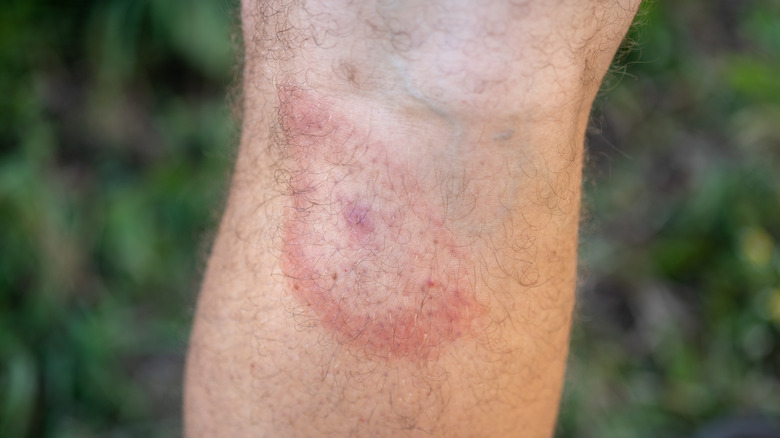Why Chronic Lyme Disease Is Such A Controversial Topic Amongst Medical Professionals
If you live on the Northeastern Seaboard of the United States, you're probably familiar with Lyme disease. A blood-borne illness primarily spread by ticks, Lyme disease can cause harmful symptoms including joint pain, fatigue, and cognitive impairments, according to the Centers for Disease Control and Prevention (CDC). Now found in all 50 states (per Harvard Health Publishing), Lyme disease is particularly commonplace in areas with thick forests and high numbers of deer.
A number of things aren't well understood about Lyme disease, including details of a version of the disease sometimes called Chronic Lyme. This condition occurs when symptoms of Lyme disease persist for more than six months after the initial infection, according to the CDC. Chronic Lyme disease affects thousands of people, with 10% to 20% of all Lyme disease infections leading to Chronic Lyme, according to The Conversation.
But the diagnosis remains very controversial, with some doctors struggling with the lack of biological evidence for Chronic Lyme and others saying that the diagnosis — which doesn't have a formal clinical definition — shouldn't be used at all (via the National Institute for Allergy and Infectious Diseases).
What is Chronic Lyme disease?
Lyme disease, in its acute form, usually sets in following a bite from a tick — small parasitic arachnids (via Britannica) which live on wildlife, including deer. In about 80% of cases, Lyme disease causes a red rash in the shape of a bulls-eye which appears a couple days after the tick bite, according to Harvard Health Publishing. However, sometimes, this rash never appears, and in those cases, Lyme disease is often not diagnosed until a month or more after the bite.
The difficulty of diagnosing Lyme disease is one factor that makes it a hard illness to treat and may contribute to the prevalence of Chronic Lyme. When Lyme disease is diagnosed in its early stages, it's treated with antibiotics, which can be a short one- or two-week course or a longer, four-week regime of therapy, per the the National Institute for Allergy and Infectious Diseases. However, sometimes even after the bacteria that causes Lyme disease disappears from lab tests, people still have symptoms like fatigue and neurological issues.
These are the cases that are sometimes called Chronic Lyme, or, as the CDC calls it, Post-Treatment Lyme Disease (via the CDC). Despite symptoms, there is no evidence of bacteria left in the body in the vast majority of these cases, making some doctors wonder if the disease exists at all, or if there might actually be something else going on.
What might cause Chronic Lyme
Some people believe that the Lyme bacteria nestles in the tissues of the body, in a place where it can no longer be detected by medical tests. In these cases, it would seem like the patients are fully recovered when they aren't, leading to Chronic Lyme symptoms. In accordance with this theory, some doctors recommend that patients with Chronic Lyme undergo much longer antibiotic treatments which can last for months. But randomized studies have suggested that these long-term antibiotics do more harm than help (via the National Institute for Allergy and Infectious Diseases).
Other theories suggest that the issue is a consequence of how Lyme disease affects the immune system (via the CDC). For instance, some scientists believe that if you are infected with another bacteria or illness at the same time as Lyme, an autoimmune response could be triggered, which could in turn cause the Chronic Lyme symptoms (via The Conversation). However, this has yet to be proven.
The medical controversy behind Chronic Lyme
Doctors who don't believe in Chronic Lyme aren't doing so out of malice toward their patients who think they have the disease. Instead, they have concerns about how the disease is diagnosed and classified and, often, they worry that people are being wrongfully diagnosed with Chronic Lyme who in fact have other conditions. For instance, the symptoms of Chronic Lyme closely mimic the symptoms of conditions like depression and fibromyalgia, according to The Conversation. Patients who in fact have one of these illnesses may be missing out on appropriate treatment if they're wrongfully diagnosed with Chronic Lyme.
Additionally, some physicians will diagnose patients with Chronic Lyme even if there is no proof that the patient had Lyme disease in the first place, according to the National Institute for Allergy and Infectious Diseases. In these cases, the diagnosis is even more controversial (via The Conversation).
On the other hand, physicians who believe strongly in the existence of Chronic Lyme, and believe it is caused by lingering bacteria, tend to say doubters are giving insufficient care to their patients (via the International Lyme and Associated Disease Society). They argue that there is substantial evidence supporting the diagnosis of Chronic Lyme (via The Connecticut Mirror).



